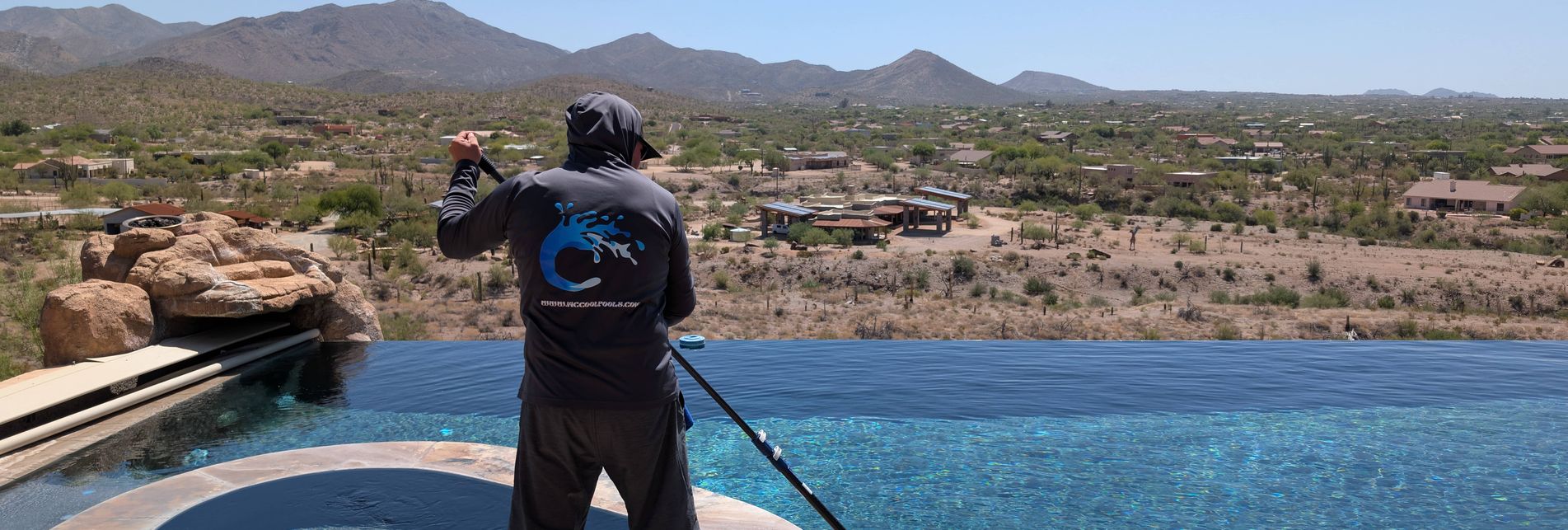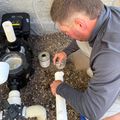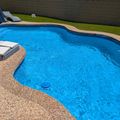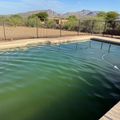Your Pool's Water Isn't Meant to Last Forever
Most pool owners assume the same water that fills their pool should stay there indefinitely—just keep adding chemicals, right? Unfortunately, that's not how pool chemistry works, especially in Arizona's extreme climate. Over time, pool water accumulates dissolved solids, minerals, and chemical byproducts that cannot be filtered out or chemically corrected. Eventually, this buildup makes proper water balance impossible, wastes money on chemicals that don't work effectively, and can even damage your pool's surfaces and equipment.
At McCool's Pools, we've serviced Phoenix-area pools for nearly two decades, and one of the most common problems we encounter is pools suffering from severe water quality issues that could have been prevented with timely draining. Understanding when and why to drain your pool—and what to do while it's empty—protects your investment and actually saves money in the long run.
Why Arizona Pools Need Draining More Often
If you've researched pool draining online, you've probably seen recommendations to drain every 5-7 years or even longer. Those guidelines don't apply to Arizona. Our extreme climate and water conditions create unique challenges that require more frequent draining:
High Evaporation Rates
Phoenix pools lose 1/4 to 1/2 inch of water daily to evaporation during summer—sometimes more during heat waves. That's 50-100 gallons per day for an average pool. While you're constantly adding fresh water to maintain level, you're only replacing the pure H2O that evaporated. All the dissolved minerals, chemicals, and contaminants remain and become increasingly concentrated.
Over a year, you might add 15,000-30,000 gallons of makeup water while the original water volume shrinks through evaporation. This concentrates everything dissolved in the water—calcium, magnesium, salts, cyanuric acid, and chemical byproducts—to problematic levels.
Hard Water Input
Phoenix municipal water contains 200-400 ppm (parts per million) of dissolved minerals, primarily calcium and magnesium. Every time you add water, you're adding more hardness. While ideal pool calcium hardness is 200-400 ppm, Arizona pools routinely climb to 600-800 ppm or higher within 2-3 years. This excessive hardness causes scaling on surfaces, tile lines, equipment, and makes water balance nearly impossible to maintain.
Cyanuric Acid Buildup
Cyanuric acid (CYA) is the stabilizer that protects chlorine from UV degradation—absolutely essential in Arizona's intense sunlight. However, CYA never degrades or evaporates. It only leaves the pool through splashout, backwashing, or draining. Most chlorine products (tablets, granular stabilized chlorine) contain CYA, continuously adding more to your pool.
Over time, CYA levels climb from the ideal 30-50 ppm to 100, 150, or even 200+ ppm. High CYA creates "chlorine lock"—your chlorine tests show adequate levels, but it's so bound up with CYA that it can't effectively sanitize. You'll struggle with cloudy water, algae growth, and wasted money on chemicals that don't work properly.
Total Dissolved Solids (TDS)
Everything that dissolves in your pool water—minerals from source water, chemicals you add, byproducts of sanitization, even sunscreen and body oils—contributes to TDS. Normal pool water contains 500-2000 ppm of TDS. Arizona pools regularly exceed 3000-5000 ppm within a few years.
High TDS makes water feel "heavy" or "old," causes cloudy water that won't clear despite proper chemistry, prevents chemicals from working effectively, increases corrosion and scaling, and creates an unhealthy swimming environment. TDS cannot be lowered except by dilution—eventually requiring a complete drain.
Salt System Considerations
Salt water pools face additional challenges. While salt doesn't evaporate (it's a dissolved solid), you're constantly adding fresh water that becomes increasingly salty as the original water evaporates. Salt concentrations can climb to levels that damage equipment, cause skin irritation, and require dilution.
Additionally, salt systems generate their own chemical byproducts that accumulate over time. Many salt pool owners discover that draining is necessary even more frequently than traditional chlorine pools.
How Often Should Arizona Pools Be Drained?
Based on nearly two decades of experience servicing pools throughout the Phoenix area, we recommend draining on the following schedule:
Traditional Chlorine Pools: Every 3-4 years Salt Water Pools: Every 2-3 years
Heavy Use Pools: Every 2-3 years Pools with Known Hard Water Issues: Every 2-3 years
These timelines assume regular weekly professional service that maintains optimal chemistry. Poorly maintained pools may require draining more frequently. The key is testing TDS, CYA, and calcium hardness levels—when these climb beyond correctable ranges, it's time to drain regardless of the schedule.
Signs Your Pool Needs Draining Now
Don't wait for a scheduled timeline if your pool exhibits these warning signs:
Water Balance is Impossible
You're constantly adjusting pH, alkalinity, and hardness, but nothing stays balanced. The water swings from one extreme to another within days. This indicates TDS has climbed so high that the water's buffering capacity is overwhelmed.
Persistent Cloudiness
Despite proper filtration, adequate chlorine, balanced chemistry, and even clarifier treatments, your water remains hazy or dull. High TDS prevents water from achieving that crystal-clear sparkle.
Algae Returns Repeatedly
You clear a green pool professionally, maintain proper chlorine levels, but algae keeps coming back. This often indicates chlorine lock from excessive cyanuric acid—your chlorine simply isn't working.
Scale Formation
White or gray deposits build up on tile lines, pool surfaces, inside equipment, and around water features. This calcium scaling indicates severe hardness that will only worsen. Left untreated, scale etches into surfaces and requires aggressive removal.
Staining Appears
Metal staining (rust-colored, purple, or black spots) develops on pool surfaces. High TDS increases metal precipitation from source water, corroded equipment, or algaecides.
Water Feels "Heavy" or "Old"
Experienced pool owners recognize when water feels different—thicker, less refreshing, harder to move through. This subjective feeling often corresponds with TDS above 3000 ppm.
Chemical Costs Escalate
You're using significantly more chemicals than normal but seeing diminishing results. High TDS water requires excessive chemical dosing because nothing works efficiently in contaminated water.
The Complete Drain and Refresh Process
Draining a pool isn't simply opening a valve and waiting—especially in Arizona's climate. Proper draining protects your pool structure, provides opportunities for maintenance and restoration, and ensures you refill with properly balanced water:
1. Pre-Drain Preparation
Timing is Critical: Never drain pools during summer heat. Extreme temperatures can crack plaster, cause structural damage, and create unbearable working conditions. The ideal window is November through March when temperatures are moderate and rainfall can even help offset water costs.
Hydrostatic Pressure Check: Arizona's deep water table typically isn't a concern, but older pools or properties near washes may have groundwater issues. Professional pool companies install hydrostatic relief plugs before draining if needed.
Permit Verification: Some Arizona cities require permits or have restrictions on pool draining, particularly regarding where water can be discharged. Check local regulations before proceeding.
2. The Drain Process
Professional draining uses submersible pumps to remove water efficiently—typically 4-8 hours for an average pool. The water is usually discharged to the street, sewer cleanout, or landscaping depending on local codes and water quality.
As water level drops, the real benefits of draining become apparent. You can finally see the pool's true condition without looking through water.
3. Inspection and Assessment
With the pool empty, this is your opportunity for a complete inspection:
- Surface condition: Cracks, chips, staining, etching, and delamination become visible
- Equipment assessment: Underwater lights, drain covers, return fittings, and pool cleaners can be inspected
- Structural issues: Shifting, settling, and stress cracks are identifiable
- Tile and coping condition: Damage, looseness, and deterioration can be evaluated
This inspection often reveals problems that would have worsened if left undetected. Catching issues while the pool is drained saves money compared to later emergency repairs.
4. Pressure Washing
Every drained pool should be pressure washed before refilling. This crucial step removes:
- Accumulated dirt, algae, and biofilm
- Loose plaster or pebble material
- Scale deposits
- Staining (some types respond to pressure washing alone)
- Calcium buildup on tile lines
Professional pressure washing uses appropriate pressure settings—too much pressure damages plaster finishes, while insufficient pressure leaves contaminants behind. The goal is a clean, sound surface ready for treatment or refilling.
5. Acid Washing (When Necessary)
Acid washing goes far beyond pressure washing, using muriatic acid to chemically etch the pool surface and remove deeply embedded stains, scale, and mineral deposits. This aggressive treatment:
Removes Stubborn Staining: Metal stains, mineral deposits, and algae staining that won't respond to pressure washing alone can be eliminated with proper acid washing.
Brightens Faded Surfaces: Years of sun exposure, chemical exposure, and scaling dull plaster finishes. Acid washing removes the thin outer layer, revealing fresh, bright plaster underneath.
Eliminates Calcium Scaling: Severe scale buildup that resists other treatments dissolves under acid washing, restoring smooth surfaces.
Improves Surface Texture: Minor roughness and etching can be smoothed through controlled acid treatment.
When Acid Washing is Recommended:
- Visible staining that doesn't respond to chemical treatment
- Severe calcium scaling
- Algae staining from previous blooms
- Dull, faded plaster that needs refreshing
- Before replastering to ensure proper bonding
Important Limitations: Acid washing removes a thin layer of plaster—typically 1/32 to 1/16 inch. Pools can only be acid washed 4-6 times over their lifetime before the plaster becomes too thin and requires complete resurfacing. This is why prevention through regular draining and maintenance is so important.
Acid washing also cannot fix structural problems, deep staining that has penetrated beyond the surface layer, or severely deteriorated plaster. In these cases, replastering may be the only solution.
6. Minor Repairs
With the pool drained, this is the ideal time for repairs:
- Crack repairs and surface patching
- Tile replacement or restoration
- Underwater light replacement or upgrades
- Drain cover updates to current safety standards
- Return fitting repairs
- Pool cleaner part replacements
Completing these repairs while drained saves the cost of draining again later for individual repairs.
7. Proper Refilling
Refilling requires careful attention:
Water Source Matters: Some Arizona pool owners use water delivery services that provide pre-softened or reverse osmosis water. While expensive, this significantly extends the time until the next drain is needed by starting with low-TDS, low-hardness water. Municipal water is more economical but brings all the minerals that necessitated draining in the first place.
Gradual Filling: Never leave a drained pool empty in direct sunlight longer than necessary. Plaster, especially, can crack or damage in heat. Begin refilling immediately after treatment is complete.
Chemical Start-Up: Fresh water needs immediate chemical treatment. Alkalinity and pH must be adjusted first, followed by calcium hardness (yes, even in Arizona you need some calcium), then chlorine and stabilizer. Starting with properly balanced water prevents surface etching and staining.
Circulation Before Heating: Run the pump for 24-48 hours before turning on the heater. This ensures chemicals are fully mixed and prevents localized chemical concentrations from damaging heat exchangers.
Cost Considerations: Drain vs. Continued Struggle
Pool owners often delay draining because of perceived costs. Let's examine the real economics:
Professional Pool Draining: $300-500 for standard drain and pressure wash Acid Wash (if needed): Additional $400-700
Water Refill: $100-250 depending on pool size and water source Chemical Start-Up: $150-300 for complete water balancing
Total Investment: $550-1,750 depending on services needed
Now consider the costs of NOT draining when needed:
- Excessive chemical usage: $50-100+ monthly in wasted chemicals
- Recurring green pool treatments: $300-500 per occurrence
- Equipment damage from scale/corrosion: $500-2,000+ for pump, heater, or filter replacement
- Surface damage from unchecked scaling: $3,000-8,000+ for acid wash or replastering
- Time and frustration: Countless hours battling chemistry that won't cooperate
A timely drain and refresh pays for itself within 6-12 months through reduced chemical costs and prevented damage. Delaying until forced by severe problems costs dramatically more than preventive maintenance.
The McCool's Pools Drain and Restoration Service
McCool's Pools provides complete drain and restoration services throughout the Phoenix area. Our systematic approach ensures your pool is properly drained, thoroughly cleaned, carefully inspected, and correctly refilled:
Safe Draining Procedures: We handle all aspects of draining including permits, discharge, and hydrostatic pressure management.
Professional Inspection: Our experienced technicians identify problems that need addressing while the pool is accessible.
Pressure Washing and Acid Washing: We use appropriate techniques for your specific pool surface and conditions.
Quality Repairs: Our in-house repair team handles all necessary fixes while the pool is drained.
Proper Chemical Start-Up: We ensure your refilled pool has perfectly balanced water from day one.
Post-Drain Monitoring: We follow up to verify everything is working correctly and water remains balanced.
Prevention Between Drains
While draining is inevitable in Arizona, you can extend the time between drains and minimize buildup:
Consistent Professional Service: Weekly maintenance catches chemistry drift before it becomes severe.
Minimize Stabilized Chlorine: When possible, use liquid chlorine or salt systems that don't add CYA. If using tablets, use them sparingly.
Dilution When Possible: During monsoon season, allow rainwater to overflow the pool slightly, providing natural dilution. Partial draining (removing 1/4-1/3 of the water) and refilling every year provides some benefit without complete draining.
Quality Source Water: Consider having makeup water tested. If your home has extremely hard water, a hose filter or occasional use of delivered water for top-offs reduces mineral accumulation.
Proper Equipment Operation: Adequate circulation and filtration reduce the need for excessive chemicals that contribute to TDS.
Don't Wait Until Damage Occurs
If your pool shows signs of high TDS, excessive hardness, or uncooperative chemistry, don't wait. The longer you delay draining, the more damage accumulates and the higher your costs climb. A preventive drain every 3-4 years costs a fraction of the repairs needed when you wait until problems become severe.
Contact McCool's Pools today to schedule your pool draining service or to have your water tested for TDS, CYA, and hardness levels. Our nearly two decades of experience with Arizona pools means we understand exactly what your pool needs—and when it needs it. Protect your investment with professional drain and restoration services that keep your pool beautiful, functional, and ready to enjoy for years to come.









